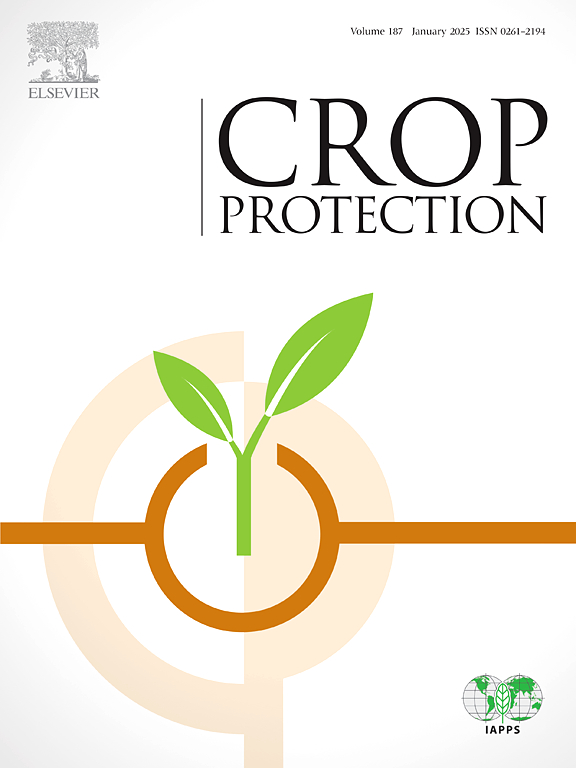Rhazya stricta Decne (Apocynaceae) "Harmal": A medicinal plant with biocontrol potential against Meloidogyne incognita in tomato
IF 2.5
2区 农林科学
Q1 AGRONOMY
引用次数: 0
Abstract
Root-knot nematodes, Meloidogyne species are top-ranking polyphagous pests in the world affecting a wide range of crops in Pakistan. Rapid climatic changes and the extensive use of nematicides have strongly impacted human health, the environment, beneficial microbial communities and the soil food web. In the current study the efficacy of crude aqueous and MeOH (methanolic) extracts of the whole plant of Rhazya stricta Decne (Apocynaceae), a medicinal Harmal bush was assessed at three different concentrations and exposure periods in vitro and in planta against M. incognita infesting tomato crops in 2020 and 2021. Besides Carbofuran, MeOH extracts @ 75 % caused maximum inhibition of egg hatching (79.5 and 80.0 %) and J2s mortality (93.4 and 92.7 %) at 24 and 72 h of exposure in both year trials, respectively. Phytochemical screening of R. stricta revealed alkaloids, flavonoids, phenols, saponins, tannins, steroids, and terpenoids. Thin layer chromatography of aqueous and MeOH extracts detected 6 and 12 bioactive compounds, respectively. Quantitative detection of MeOH extracts produced higher amounts of total phenols (30.56 ± 0.16 mg/g), flavonoids (21.85 ± 0.03 mg/g), and alkaloids (96.7 ± 0.17 mg/g). In planta greenhouse and field assays on tomatoes, MeOH extracts @ 75 % produced highly significant (P = 0.00) results and exhibited no phytotoxic effects. It markedly suppressed a number of galls; galling indices, a number of J2s 100 cm−3 soil, adult females, egg masses and reproduction factor. MeOH extracts substantially increased plant growth and yield parameters under controlled and open field conditions. This research demonstrates the potential of R. stricta as a novel sustainable and eco-friendly strategy for M. incognita in tomato crops, providing a viable alternative to chemical nematicides with low cost and low environmental risks.

麻麻(夹竹桃科)有害植物:一种具有生物防治潜力的药用植物
根结线虫(Meloidogyne)是世界上排名第一的多食性害虫,影响巴基斯坦的多种作物。快速的气候变化和杀线虫剂的广泛使用严重影响了人类健康、环境、有益微生物群落和土壤食物网。本研究研究了夹竹桃科药用灌木Rhazya stricta Decne (Apocynaceae)全株粗水提物和甲醇(MeOH)提取物在体外和植株上三种不同浓度和暴露时间下对2020年和2021年番茄作物侵染M. incognita的效果。除Carbofuran外,75%的MeOH提取物在24和72 h时对卵孵化率的抑制作用最大(分别为79.5%和80.0%),对js死亡率的抑制作用最大(分别为93.4%和92.7%)。植物化学筛选结果显示,芦笋中含有生物碱、黄酮类、酚类、皂苷、单宁、甾体和萜类化合物。水溶液和甲醇提取物的薄层色谱分别检测到6种和12种生物活性化合物。定量检测MeOH提取物总酚(30.56±0.16 mg/g)、总黄酮(21.85±0.03 mg/g)、生物碱(96.7±0.17 mg/g)含量较高。在温室和田间番茄试验中,75%的MeOH提取物产生了非常显著的结果(P = 0.00),并且没有显示出植物毒性作用。它明显抑制了一些胆囊;骚扰指数、J2s数量、100 cm−3土壤、成虫、卵量和繁殖因子。在控制和开放条件下,MeOH提取物显著提高了植物生长和产量参数。本研究表明,在番茄作物中使用窄纹线虫作为一种新的可持续和生态策略,具有低成本和低环境风险,是一种可行的化学杀线虫剂替代品。
本文章由计算机程序翻译,如有差异,请以英文原文为准。
求助全文
约1分钟内获得全文
求助全文
来源期刊

Crop Protection
农林科学-农艺学
CiteScore
6.10
自引率
3.60%
发文量
200
审稿时长
29 days
期刊介绍:
The Editors of Crop Protection especially welcome papers describing an interdisciplinary approach showing how different control strategies can be integrated into practical pest management programs, covering high and low input agricultural systems worldwide. Crop Protection particularly emphasizes the practical aspects of control in the field and for protected crops, and includes work which may lead in the near future to more effective control. The journal does not duplicate the many existing excellent biological science journals, which deal mainly with the more fundamental aspects of plant pathology, applied zoology and weed science. Crop Protection covers all practical aspects of pest, disease and weed control, including the following topics:
-Abiotic damage-
Agronomic control methods-
Assessment of pest and disease damage-
Molecular methods for the detection and assessment of pests and diseases-
Biological control-
Biorational pesticides-
Control of animal pests of world crops-
Control of diseases of crop plants caused by microorganisms-
Control of weeds and integrated management-
Economic considerations-
Effects of plant growth regulators-
Environmental benefits of reduced pesticide use-
Environmental effects of pesticides-
Epidemiology of pests and diseases in relation to control-
GM Crops, and genetic engineering applications-
Importance and control of postharvest crop losses-
Integrated control-
Interrelationships and compatibility among different control strategies-
Invasive species as they relate to implications for crop protection-
Pesticide application methods-
Pest management-
Phytobiomes for pest and disease control-
Resistance management-
Sampling and monitoring schemes for diseases, nematodes, pests and weeds.
 求助内容:
求助内容: 应助结果提醒方式:
应助结果提醒方式:


